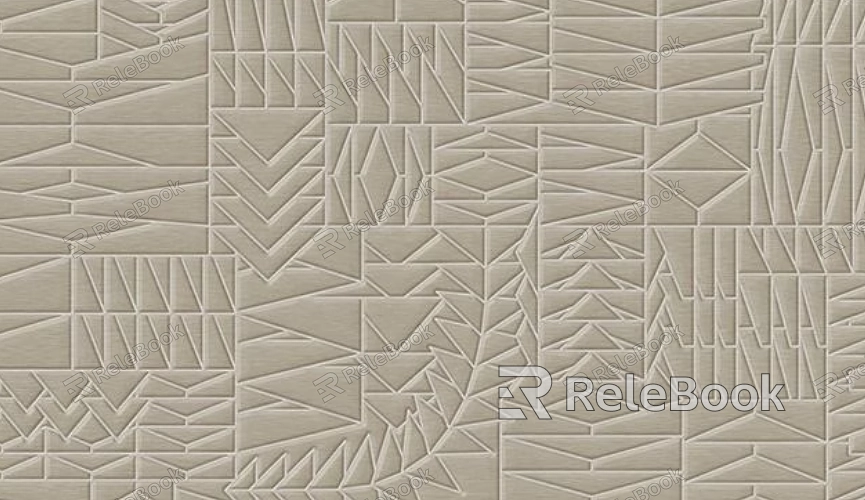How to Import Textures on a 3D Model?
Textures are essential in transforming a plain 3D model into something lifelike by adding details, color, and shininess. For many 3D artists and designers, importing textures is one of the most frequent tasks in their workflow. In this guide, I will share practical methods for importing textures onto 3D models, addressing common issues and helping you improve your efficiency.

1. Prepare Texture Files
Before importing textures, it’s important to have the necessary texture files ready. These files usually include:
Image Textures: Formats like JPG, PNG, TIFF, etc., often used for color maps, normal maps, roughness maps, and more.
PBR Textures: These are Physically Based Rendering (PBR) textures, which typically consist of multiple channels such as color, normal, metalness, roughness, etc.
If you find sourcing high-quality 3D textures time-consuming or complicated, you can directly visit Relebook to download a range of beautifully crafted 3D textures for your projects.
2. Unwrap the UVs
In 3D modeling, UV unwrapping is the process of "unfolding" a 3D model's surface into a 2D plane for texturing. This step is crucial because improper UV mapping can lead to distorted textures.
In Blender: Use the UV editor to unwrap your model, ensuring each face has the correct mapping.
In 3ds Max: Apply the UVW Unwrap modifier to unfold the model and adjust the UV layout.
While unwrapping, avoid overlapping or stretching the UVs to ensure that the textures are applied evenly across the surface of the model.
3. Import Textures into Your Modeling Software
Once the UVs are unwrapped, the next step is to import the textures into your modeling software. Each program has a different import process:
In Blender: Open the UV editor, click "New Texture," and choose your desired image file. You can then apply it to the model’s surfaces.
In 3ds Max: Create a new material in the Material Editor, load the texture, and apply it to the model.
After importing the texture, adjust the tiling, offset, and rotation to ensure that the texture fits the model correctly.
4. Adjust Material Properties
Once the textures are imported, the next task is to fine-tune the material properties, including glossiness, transparency, reflectivity, and more. These settings will directly impact the final render.
Reflection Settings: Adjust the highlights and reflectivity to control whether the surface appears glossy.
Normal Maps: Add normal maps to create subtle bumps and fine details on the surface.
Roughness and Metalness: In a PBR workflow, adjust these attributes to make the texture look more realistic.
For PBR textures, ensure that each channel (roughness, metalness, etc.) is properly loaded and applied to the material.

5. Rendering Tests and Optimization
After importing the textures, conducting a rendering test is a critical step. This helps you check for issues like texture stretching, repetition, or misalignment. Based on the results, you can adjust the textures to ensure the final render meets your expectations.
For optimization, you can reduce texture resolution, remove unnecessary details, or use compressed texture formats to lessen the rendering load and increase rendering efficiency.
6. Import Textures into Rendering Software
During the rendering stage, many designers import their models and textures into rendering software like Unreal Engine or Unity. This process is essential for finalizing the look and performance of the model in a real-time environment.
In Unreal Engine: Drag the texture file into the Material Editor, create the material, and apply it to the model. PBR workflows are particularly important in Unreal Engine.
In Unity: Create a new material in the Material Editor, import the texture maps, and adjust the related parameters to ensure the effect matches the design.
The goal here is to ensure that the textures display correctly in the final rendering environment while maintaining performance.
7. Troubleshooting Common Issues
Throughout the texture import process, designers often encounter problems. Common issues include texture distortion, stretching, or tiling, often caused by improper UV unwrapping. Another issue could be inconsistent texture colors due to incorrect lighting or material settings.
To resolve these, you can:
Adjust the UV mapping,
Tweak material settings,
Test different texture file formats.
Through continuous testing and optimization, you can enhance the quality of your textures on the model and ensure the best rendering results.
If you're looking for high-quality 3D textures, SketchUp models, or 3ds Max models to create virtual scenes, Relebook offers a wide range of options to help you achieve stunning visuals in your projects.
This guide should give you a better understanding of the texturing process and help streamline your workflow for importing textures into 3D models. Happy modeling!

